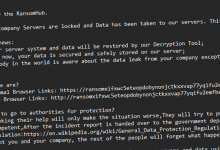The ever-accelerating pace of technological advancement shapes our world, forging a double-edged digital landscape. On one hand, it fuels innovation and fosters connection while simultaneously becoming a dynamic battleground where security threats constantly evolve.
Phishing scams lurk like cunning predators; ransomware attacks loom like digital storms, and the turbulent cyber threat landscape of 2023 demands immediate attention.
As we step into 2024, the need for robust cybersecurity strategies rises to the forefront. To address this critical need, The Cyber Express Team has crafted a guide that transcends mere theoretical discussions. This roadmap provides practical guidance through eight essential cybersecurity best practices, venturing beyond the ordinary.
This is not your run-of-the-mill guide. It eschews clichés and delves into uncharted territories of defense, empowering you with the knowledge and strategies needed to navigate the digital frontier with confidence.
Cybersecurity Best Practices in 2024
1. Implement Strong Authentication Measures:
Implementing strong authentication measures stands as a cornerstone in the arsenal of cybersecurity best practices for 2024. Gone are the days when a mere password was sufficient to safeguard digital fortresses. In this era, multifactor authentication (MFA) emerges as a stalwart defender, requiring users to go beyond traditional password inputs.
Consider a scenario where, in addition to entering a password, users receive a one-time verification code on their smartphones. This dual-layered approach ensures that even if a password is compromised, unauthorized access remains thwarted. Biometric authentication, such as fingerprint or facial recognition, further elevates the security game.
For instance, in March 2022, the cybersecurity world saw a major incident when the infamous Lapsus$ hacking group infiltrated Okta, a popular IAM provider. This breach exposed sensitive data from many organizations, including major companies such as Autodesk, Cloudflare, and GitLab. Okta later admitted that the breach occurred due to a lack of multi-factor authentication (MFA) for its SuperAdmins.
Similarly, Cisco exposes data of millions of customers due to weak authentication: Cisco was forced to notify millions of customers that their data had been exposed due to a weak authentication vulnerability in its Webex cloud collaboration platform. The vulnerability allowed attackers to steal authentication tokens and gain unauthorized access to customer accounts.
By requiring multiple forms of verification, strong authentication significantly reduces the vulnerability of accounts and systems to cyber threats, providing an extra layer of defense against unauthorized access and potential breaches.
“Remember, the only thing ‘password123’ is protecting is your reputation as a hacker’s best friend. It’s like using a cardboard shield in a digital swordfight – you might as well be handing them the victory on a silver platter! So, get your creative juices flowing, mix up uppercase and lowercase letters, throw in some numbers and special characters, and create a password that’s so complex that even Sherlock Holmes would struggle to decipher it,” said Dr. Devam R Shah, CISO and Head of IT at Teachmint.
2. Regularly Update Software and Systems
Maintaining up-to-date software and systems is a cornerstone of effective cybersecurity practices in 2024, comparable to securing physical doors and windows to deter break-ins.
Similar to advancements in lock technology to outsmart burglars, software updates often include critical security patches to thwart cyber threats. Whether it involves operating systems, antivirus programs, or applications, staying vigilant about updates is paramount.
For example, in February 2023, T-Mobile experienced its second data breach of the year, exposing PINs, full names, and phone numbers of over 800 customers. This breach resulted from a vulnerability in T-Mobile’s systems identified months earlier but left unpatched. Likewise, in October 2023, a data breach compromised the information of 23andMe customers due to a vulnerability in the company’s systems identified in 2021 but left unaddressed.
Major platforms such as Microsoft Windows and macOS consistently release security updates to address vulnerabilities. Overlooking these updates is akin to leaving a back door open for cybercriminals to exploit known weaknesses.
3. Educate and Train Employees
Educating and training employees goes beyond relying solely on a tech-savvy IT team; every individual within an organization is a linchpin in maintaining a secure digital environment.
As Santosh Kamane, Co-Founder & CEO of CyberFIT Solutions Pvt Ltd, aptly puts it, “People are informational assets for every organization and when educated, they can be strongest link in the security chain.”
Illustrating the significance of employee awareness, the data breach at Tesla, compromising the information of over 75,000 people, was attributed to “insider wrongdoing.” Two former employees violated Tesla’s data protection policies by sharing sensitive information with a German media outlet, leading to a lawsuit filed by the Musk-owned company. The breach exposed 100 gigabytes of personal employee data, including Elon Musk’s social security number.
Conducting regular workshops and simulations to raise awareness about phishing threats. These sessions not only shed light on the various phishing tactics but also empower employees to identify and thwart potential attacks. An interactive training module that simulates a ransomware scenario, allowing staff to practice their response in a controlled environment.
By instilling a culture of cybersecurity awareness through hands-on education, organizations can transform their workforce into a formidable line of defense against the ever-evolving landscape of cyber threats in the year ahead. This proactive approach, as endorsed by Kamane, emphasizes the pivotal role each individual plays in fortifying the overall security posture.
4. Employ Advanced Endpoint Protection
Serving as a comprehensive digital shield, this approach extends beyond traditional antivirus measures, utilizing cutting-edge technologies such as machine learning and behavioral analysis.
It acts as a vigilant digital guardian, capable of detecting and neutralizing potential threats in real-time, fortifying defenses against evolving risks. Examples like CrowdStrike and SentinelOne showcase the power of artificial intelligence to proactively respond to cyber threats, ensuring a resilient defense posture.
5. Encrypt Sensitive Data
Just like sealing a letter in an envelope before sending it, encryption involves scrambling information into an unreadable format that can only be deciphered with the correct key. Picture this as your digital lock and key, ensuring that even if unauthorized eyes catch a glimpse, the content remains incomprehensible.
For instance, when you send login details over the internet, encryption shields them from prying eyes. A classic example is the HTTPS protocol, where websites use encryption to secure the data exchanged between users and the site, guaranteeing a safer online experience.
In an era where data is the new gold, encrypting sensitive information acts as an imperative shield, safeguarding against potential breaches and unauthorized access.
6. Embracing Threat Intelligence Platforms
As we navigate through 2024, the cybersecurity landscape presents increasingly complex challenges. In response, the integration of advanced threat intelligence platforms has become more than a luxury—it’s a necessity.
These platforms serve a vital role in safeguarding digital infrastructures, acting as vigilant sentinels in an ever-evolving digital environment. The core function of these platforms lies in their ability to aggregate and analyze data from a multitude of sources. This process equips organizations with real-time insights, enabling them to stay one step ahead of potential cyber threats.
By leveraging these platforms, businesses can proactively identify vulnerabilities, anticipate cyber-attacks, and implement effective defenses on time. In this arena of digital defense, Cyble stands out as a prime example of excellence. It exemplifies the ideal blend of comprehensive features like Dark Web Monitoring, ASM, Vulnerability Management, Incident Response, and more.
Choosing a threat intelligence platform like Cyble is not just adopting a tool; it’s embracing a strategic imperative. For organizations dedicated to maintaining a resilient and proactive cybersecurity posture, platforms like Cyble offer an indispensable shield in the battle against digital threats.
7. Conduct Regular Security Audits and Assessments
Think of it as giving your digital defenses a health check-up – it’s not about waiting for symptoms; it’s about proactive prevention. By routinely examining your systems, networks, and applications, you can identify vulnerabilities before they become gateways for cyber intruders. For instance, consider simulating a phishing attack on your organization’s email system during these assessments.
This hands-on approach allows you to gauge the effectiveness of your current security measures and implement necessary improvements. Additionally, by leveraging automated tools that scan for vulnerabilities or conducting penetration testing, you can mimic real-world cyber threats and fortify your defenses accordingly.
8. Establish an Incident Response Plan
In 2024, adherence to cybersecurity best practices mandates that organizations establish a robust Incident Response Plan (IRP) as a foundational element of their security posture. The significance of this is highlighted by reports revealing that 36% of organizations in the Asia Pacific lack an incident response playbook, and 38% do not have a designated data protection officer or access to cybersecurity specialists.
A pertinent example illustrating the repercussions of inadequate data security practices is the recent case of Morgan Stanley, facing a US$6.5 million fine for compromising customer data. This breach occurred during device decommissioning, resulting in unauthorized sales and missing servers. The distributed financial penalty across multiple states emphasizes the gravity of lax data security, with mandated improvements including encryption measures and comprehensive data management policies.
A well-structured IRP is a systematic approach that outlines step-by-step procedures to be followed in the event of a cybersecurity incident.
For instance, if a company detects a sophisticated malware attack attempting to compromise sensitive data, an effective IRP would involve predefined roles and responsibilities for the incident response team, a clear communication protocol for stakeholders and the public, and a detailed recovery plan to minimize downtime and data loss.
To further fortify your organization’s cybersecurity stance, regularly check if your email ID has been compromised or leaked using tools like AmIBreached. This additional layer of vigilance complements the Incident Response Plan, enhancing your organization’s overall cybersecurity preparedness in the ever-evolving landscape of 2024.
Additionally, proactive measures like regular simulations and training exercises can be integrated into the IRP to ensure the team is well-prepared to handle evolving cyber threats. Establishing an IRP not only enhances an organization’s ability to detect, respond, and recover promptly from cyber incidents but also contributes to the overall resilience and cybersecurity maturity of the enterprise in the dynamic landscape of 2024.
To Warp Up
As we traverse the digital frontier, embracing these strategies isn’t just a recommendation—it’s a commitment to building a resilient cybersecurity posture that safeguards organizations from the intricate challenges of the dynamic cyber landscape in the years to come.
“By instilling a culture of vigilance and best practices, it empowers individuals to protect sensitive information, preserve privacy, and fortify the foundations of a secure digital society both in personal and professional life. Moreover, its impact reverberates through the realms of business and national security, solidifying its status as an indispensable component of contemporary digital existence,” said Santosh Tripathi, Director – Information Security & Compliance, Virsec.
The Cyber Express Team stands ready to guide and empower, ensuring that your journey through the digital realm remains secure and fortified.





